turn signal SSANGYONG KORANDO 2013 Workshop Manual
[x] Cancel search | Manufacturer: SSANGYONG, Model Year: 2013, Model line: KORANDO, Model: SSANGYONG KORANDO 2013Pages: 1336, PDF Size: 92.18 MB
Page 768 of 1336
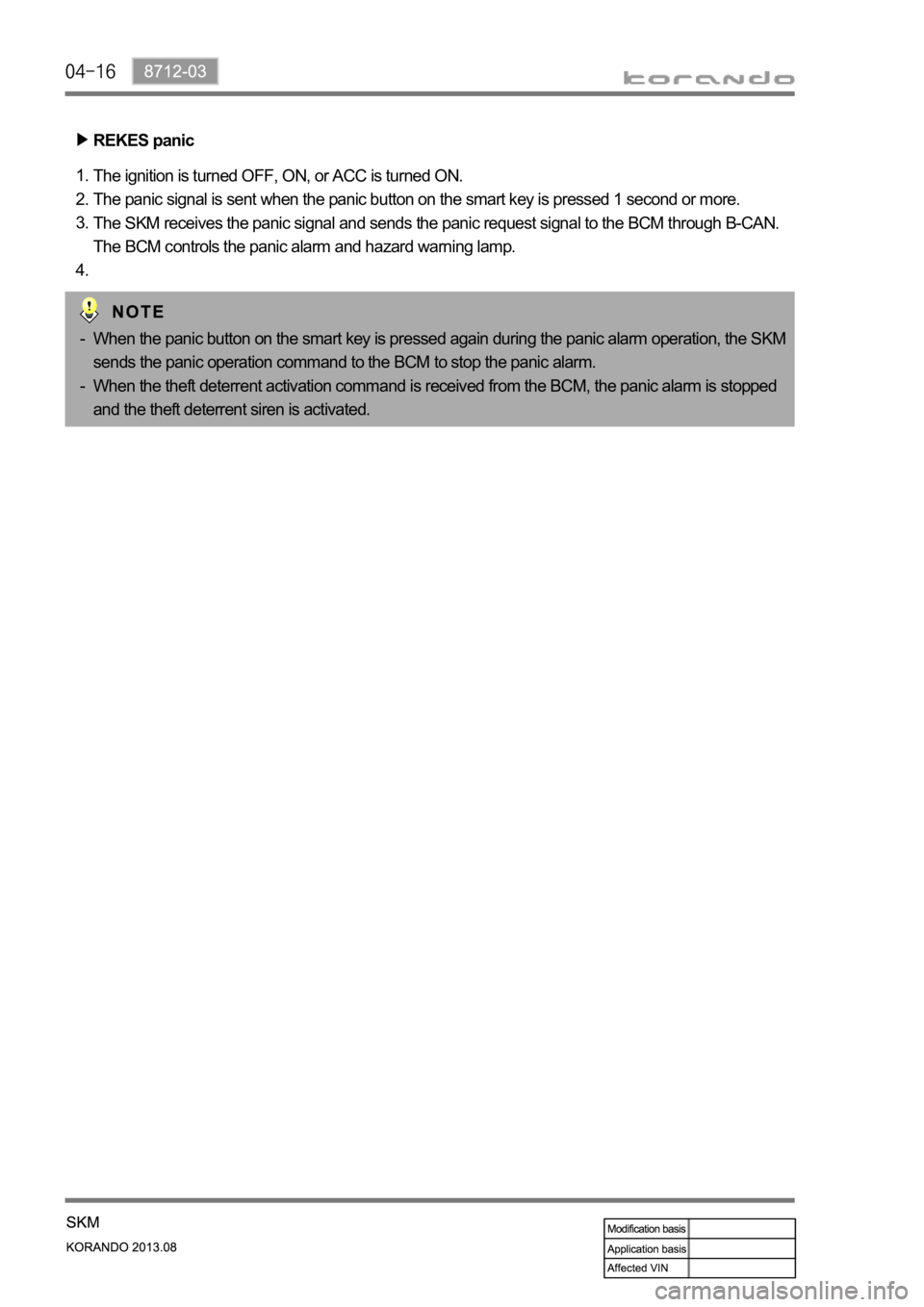
REKES panic
The ignition is turned OFF, ON, or ACC is turned ON.
The panic signal is sent when the panic button on the smart key is pressed 1 second or more.
The SKM receives the panic signal and sends the panic request signal to the BCM through B-CAN.
The BCM controls the panic alarm and hazard warning lamp. 1.
2.
3.
4.
When the panic button on the smart key is pressed again during the panic alarm operation, the SKM
sends the panic operation command to the BCM to stop the panic alarm.
When the theft deterrent activation command is received from the BCM, the panic alarm is stopped
and the theft deterrent siren is activated. -
-
Page 770 of 1336
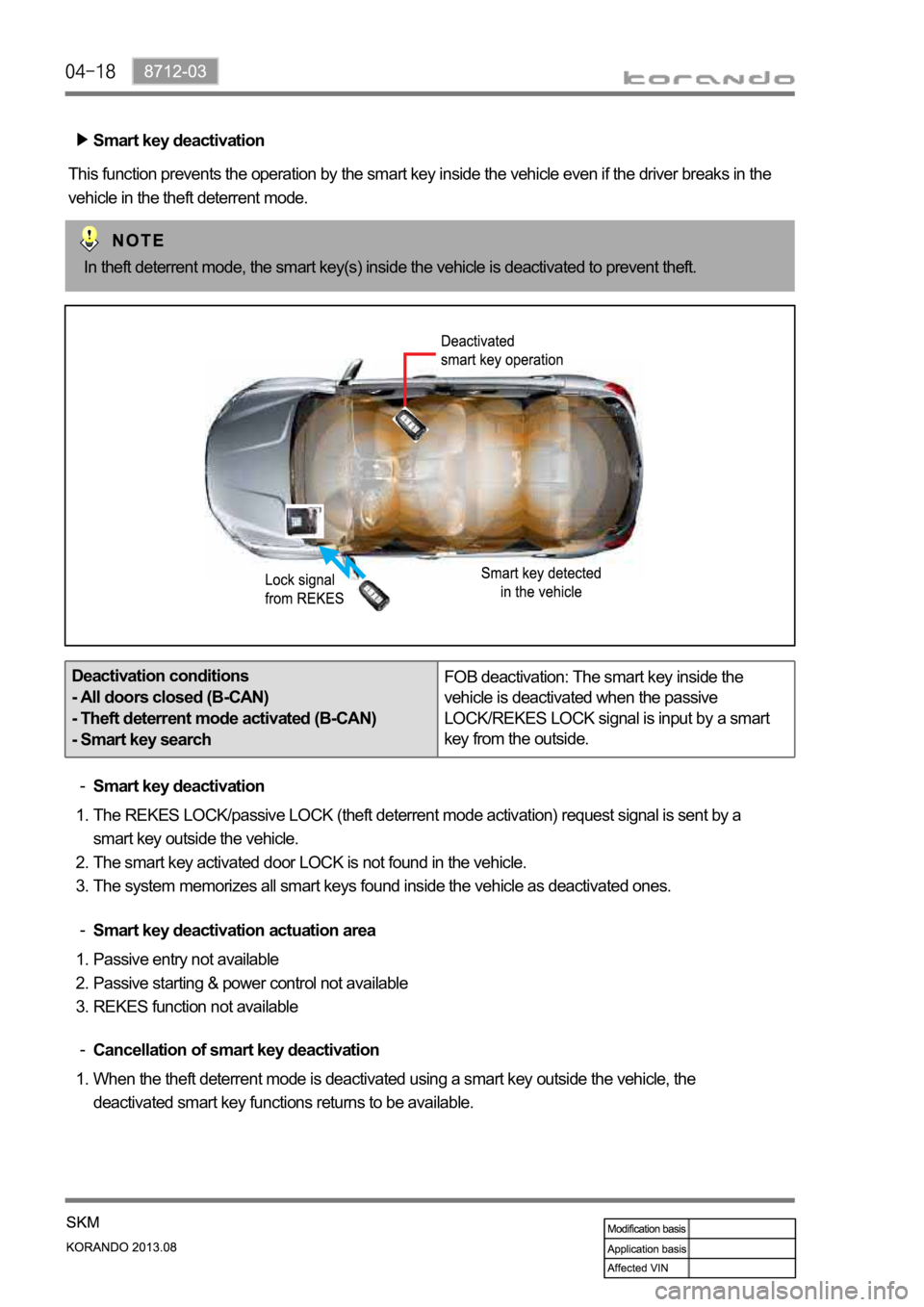
Smart key deactivation
This function prevents the operation by the smart key inside the vehicle even if the driver breaks in the
vehicle in the theft deterrent mode.
Deactivation conditions
- All doors closed (B-CAN)
- Theft deterrent mode activated (B-CAN)
- Smart key searchFOB deactivation: The smart key inside the
vehicle is deactivated when the passive
LOCK/REKES LOCK signal is input by a smart
key from the outside.
Smart key deactivation -
The REKES LOCK/passive LOCK (theft deterrent mode activation) request signal is sent by a
smart key outside the vehicle.
The smart key activated door LOCK is not found in the vehicle.
The system memorizes all smart keys found inside the vehicle as deactivated ones. 1.
2.
3.
Smart key deactivation actuation area -
Passive entry not available
Passive starting & power control not available
REKES function not available 1.
2.
3.
Cancellation of smart key deactivation -
When the theft deterrent mode is deactivated using a smart key outside the vehicle, the
deactivated smart key functions returns to be available. 1.In theft deterrent mode, the smart key(s) inside the vehicle is deactivated to prevent theft.
Page 774 of 1336
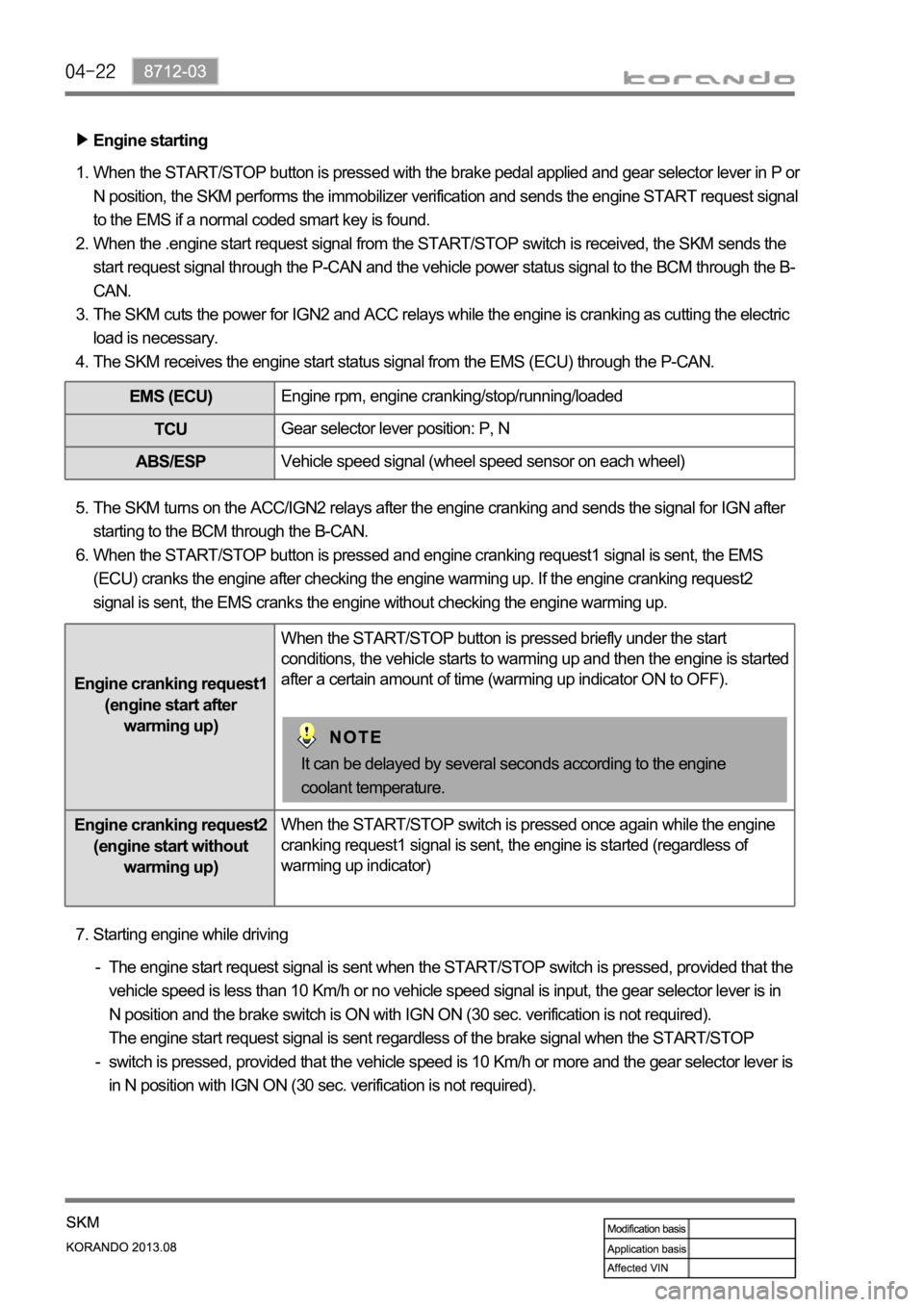
Engine starting
When the START/STOP button is pressed with the brake pedal applied and gear selector lever in P or
N position, the SKM performs the immobilizer verification and sends the engine START request signal
to the EMS if a normal coded smart key is found.
When the .engine start request signal from the START/STOP switch is received, the SKM sends the
start request signal through the P-CAN and the vehicle power status signal to the BCM through the B-
CAN.
The SKM cuts the power for IGN2 and ACC relays while the engine is cranking as cutting the electric
load is necessary.
The SKM receives the engine start status signal from the EMS (ECU) through the P-CAN. 1.
2.
3.
4.
EMS (ECU)Engine rpm, engine cranking/stop/running/loaded
TCUGear selector lever position: P, N
ABS/ESPVehicle speed signal (wheel speed sensor on each wheel)
The SKM turns on the ACC/IGN2 relays after the engine cranking and sends the signal for IGN after
starting to the BCM through the B-CAN.
When the START/STOP button is pressed and engine cranking request1 signal is sent, the EMS
(ECU) cranks the engine after checking the engine warming up. If the engine cranking request2
signal is sent, the EMS cranks the engine without checking the engine warming up. 5.
6.
Engine cranking request1
(engine start after
warming up)When the START/STOP button is pressed briefly under the start
conditions, the vehicle starts to warming up and then the engine is started
after a certain amount of time (warming up indicator ON to OFF).
Engine cranking request2
(engine start without
warming up)When the START/STOP switch is pressed once again while the engine
cranking request1 signal is sent, the engine is started (regardless of
warming up indicator)
It can be delayed by several seconds according to the engine
coolant temperature.
Starting engine while driving 7.
The engine start request signal is sent when the START/STOP switch is pressed, provided that the
vehicle speed is less than 10 Km/h or no vehicle speed signal is input, the gear selector lever is in
N position and the brake switch is ON with IGN ON (30 sec. verification is not required).
The engine start request signal is sent regardless of the brake signal when the START/STOP
switch is pressed, provided that the vehicle speed is 10 Km/h or more and the gear selector lever is
in N position with IGN ON (30 sec. verification is not required). -
-
Page 775 of 1336
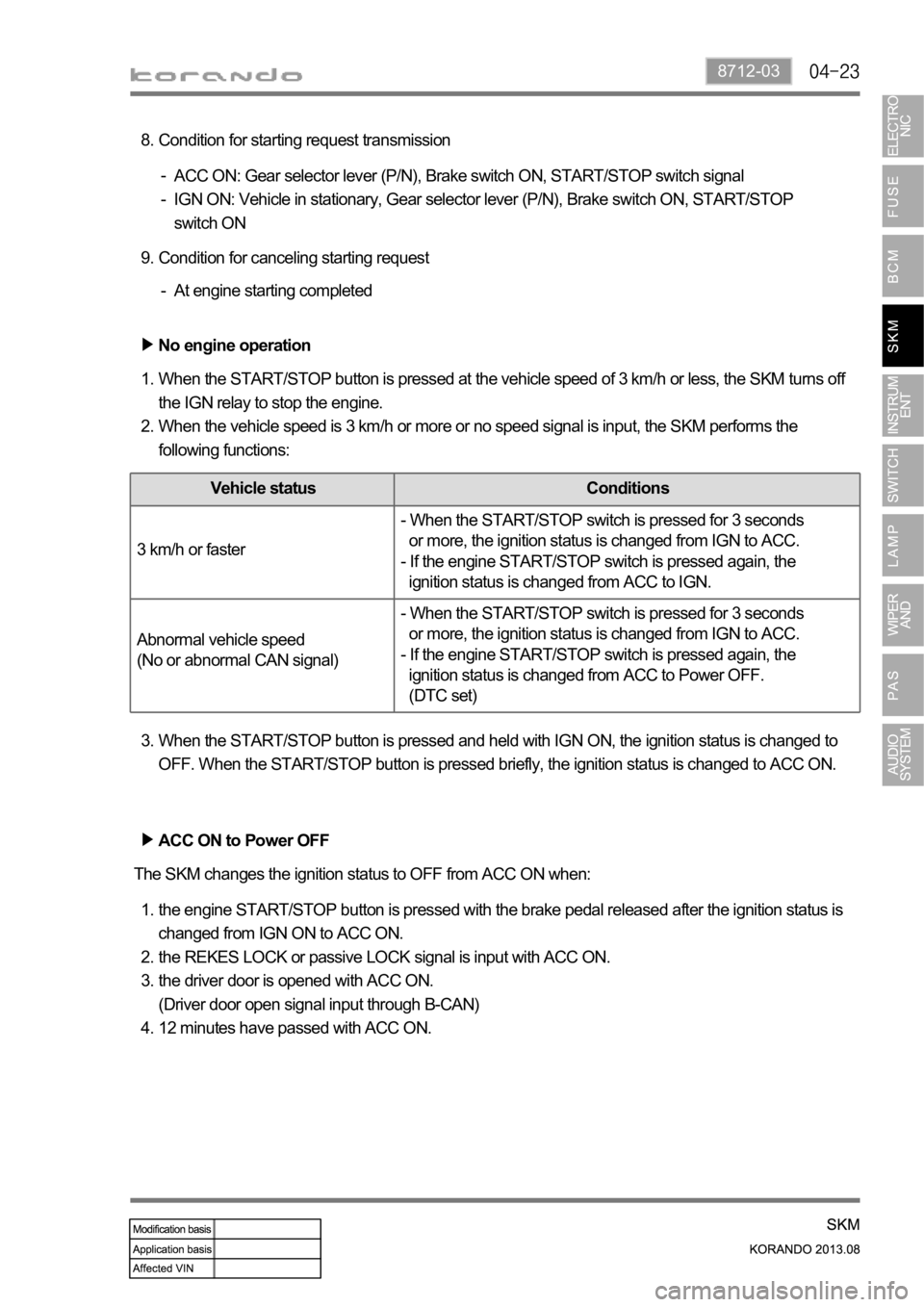
8712-03
No engine operation
When the START/STOP button is pressed at the vehicle speed of 3 km/h or less, the SKM turns off
the IGN relay to stop the engine.
When the vehicle speed is 3 km/h or more or no speed signal is input, the SKM performs the
following functions: 1.
2.
Vehicle status Conditions
3 km/h or faster - When the START/STOP switch is pressed for 3 seconds
or more, the ignition status is changed from IGN to ACC.
- If the engine START/STOP switch is pressed again, the
ignition status is changed from ACC to IGN.
Abnormal vehicle speed
(No or abnormal CAN signal)- When the START/STOP switch is pressed for 3 seconds
or more, the ignition status is changed from IGN to ACC.
- If the engine START/STOP switch is pressed again, the
ignition status is changed from ACC to Power OFF.
(DTC set)
When the START/STOP button is pressed and held with IGN ON, the ignition status is changed to
OFF. When the START/STOP button is pressed briefly, the ignition status is changed to ACC ON. 3.
ACC ON to Power OFF
The SKM changes the ignition status to OFF from ACC ON when:
the engine START/STOP button is pressed with the brake pedal released after the ignition status is
changed from IGN ON to ACC ON.
the REKES LOCK or passive LOCK signal is input with ACC ON.
the driver door is opened with ACC ON.
(Driver door open signal input through B-CAN)
12 minutes have passed with ACC ON. 1.
2.
3.
4.Condition for starting request transmission 8.
ACC ON: Gear selector lever (P/N), Brake switch ON, START/STOP switch signal
IGN ON: Vehicle in stationary, Gear selector lever (P/N), Brake switch ON, START/STOP
switch ON -
-
Condition for canceling starting request 9.
At engine starting completed -
Page 776 of 1336
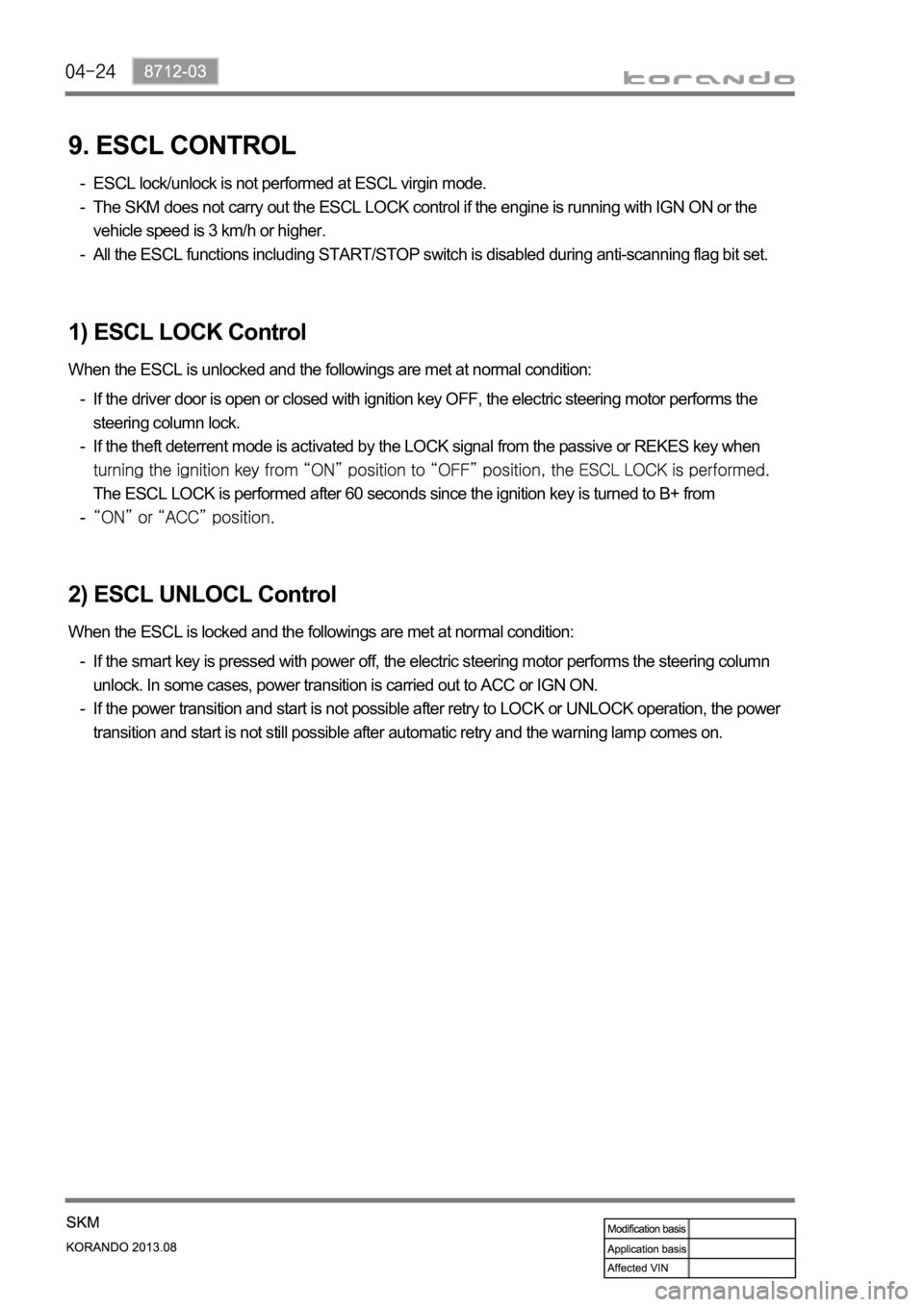
9. ESCL CONTROL
ESCL lock/unlock is not performed at ESCL virgin mode.
The SKM does not carry out the ESCL LOCK control if the engine is running with IGN ON or the
vehicle speed is 3 km/h or higher.
All the ESCL functions including START/STOP switch is disabled during anti-scanning flag bit set. -
-
-
If the smart key is pressed with power off, the electric steering motor performs the steering column
unlock. In some cases, power transition is carried out to ACC or IGN ON.
If the power transition and start is not possible after retry to LOCK or UNLOCK operation, the power
transition and start is not still possible after automatic retry and the warning lamp comes on. -
-
1) ESCL LOCK Control
When the ESCL is unlocked and the followings are met at normal condition:
If the driver door is open or closed with ignition key OFF, the electric steering motor performs the
steering column lock.
If the theft deterrent mode is activated by the LOCK signal from the passive or REKES key when
The ESCL LOCK is performed after 60 seconds since the ignition key is turned to B+ from
-
-
-
2) ESCL UNLOCL Control
When the ESCL is locked and the followings are met at normal condition:
Page 779 of 1336

8712-03
11. SKM WARNING CONTROL
(1) Smart Key Not Detected Warning
With ACC ON
Smart key not detected warning deactivation conditions
- ACC OFF, IGN1 ON, Smart key detected
IGN ON and engine running
Smart key not detected warning deactivation conditions
- IGN1 OFF, Smart key detected, Door openAny door except the driver door is opened and then closed.
The SKM starts to identify a smart key by using the interior antenna after confirming that all the doors
are closed through CAN communication with the BCM.
When no smart key is found, the SKM sends the smart key not detected warning signal to the BCM
and instrument cluster through B-CAN.
The BCM activates the buzzer for up to 10 seconds at intervals of 0.5 sec. ON/0.5 sec. OFF and
turns on the smart key warning indicator on the instrument cluster.
If a smart key is found, no operation is performed. 1.
2.
3.
4.
5.
Any door except the driver door is opened and then closed.
The smart key not detected warning is not activated.
the smart key not detected warning signal to the BCM and instrument cluster through B-CAN.
The smart key not detected warning is activated.
- Smart key searching at intervals of 3 seconds using the interior antenna. 1.
2.
3.
Page 780 of 1336

(2) Smart Key Detected Warning (Smart Key Found Inside Vehicle)
Smart key deactivation warning
The ignition is turned OFF or ACC is turned ON.
A verified smart key found in the vehicle with all doors (including tailgate) closed.
The REKES LOCK or passive LOCK signal is input with a valid smart key from the outside the
vehicle.
The SKM sends the theft deterrent mode signal to the BCM through B-CAN and the verified smart
key is found inside the vehicle.
The SKM sends the smart key detected warning to the BCM and instrument cluster through B-CAN.
The BCM activates the buzzer for up to 10 seconds at intervals of 0.5 sec. ON/0.5 sec. OFF and
turns on the smart key detected warning indicator on the instrument cluster. 1.
2.
3.
4.
5.
6.
Smart key inside vehicle warning
The ignition is turned ON or OFF, or the ACC is turned ON.
A verified smart key found only in the vehicle (including emergency slot) with all doors (including
tailgate) closed.
The passive LOCK signal is input without a valid smart key from the outside the vehicle.
The SKM sends the theft deterrent mode signal to the BCM through B-CAN and the verified smart
key is found inside the vehicle.
The SKM sends the smart key detected warning to the BCM and instrument cluster through B-CAN.
The BCM activates the buzzer for up to 10 seconds at intervals of 0.5 sec. ON/0.5 sec. OFF and
turns on the smart key detected warning indicator on the instrument cluster. 1.
2.
3.
4.
5.
6.Smart key detected warning deactivation conditions
- The theft deterrent mode is deactivated.
Smart key detected warning deactivation conditions
- No smart key is found inside the vehicle when a door is opened and then closed.
Page 786 of 1336

3) Operating Process
Key verification can be divided into two types, immobilizer key verification and smart key verification. The
immobilizer verification is applied for the SKM system, and verifies the transponder built in the smart key.
When the smart key is inserted into the slot, the verification is carried out, overriding the RF signal from
the smart key.
The power is supplied to the slot when the START/STOP switch is pressed with the smart key inserted
into the slot, and the smart key transponder verification is carried out by the transponder communication.
Once the key is verified, a valid key verification time is provided for 10 seconds and the engine can be
started by pressing the START/STOP switch during this time. If pressing the START/STOP switch after
this 10 seconds, the key verification process is performed again.
When the ignition is turned ON, the EMS (ECU) sends the challenge message to the SKM through
the P-CAN. (This is to verify whether the transponder of the smart key is valid. If the verification fails,
it transmits the re-verification signals 3 times for 2 seconds. If 3rd re-verification fails, the verification
is deactivated for 10 seconds and re-activated after that.)
The immobilizer slot of the SKM system sends the encrypted cod to the transponder, and the
transponder re-sends the encrypted code to the immobilizer slot.
The encrypted sent to the immobilizer slot is re-sent to the SKM.
The SKM compares this code with the encrypted code randomly transmitted by the internal logic.
(System compares the signal from transponder and encrypted signal from the immobilizer control
unit)
Only when the two signals are identical, it recognizes the key as the verified one and transmits the
positive message to the ECU.
The ECU enables the engine to be started. 1.
2.
3.
4.
5.
6.
Page 799 of 1336

8010-01
Indicator
(amber)
ESP
ESP OFF indicator
Engine check warning lamp
Indicator
(amber)
Indicator
(amber)
Indicator (red)
Battery charge warning lamp
Indicator (red)
Engine oil level warning lamp
This lamp comes on if any sensor or device related to the engine control is
defective.
This lamp comes on when the start switch is ON or when the battery level is
low.
(For EEM, warning lamp is controlled according to CAN signal)
This lamp comes on when the ignition switch is turned to "ON" position,
and then goes off if the engine oil level is normal.
If the engine oil level warning lamp comes on while driving, check the
engine oil level and oil leakage. -
- This indicator comes on when the ESP system is faulty.
This indicator comes on when pressing the ESP OFF switch.
Page 802 of 1336
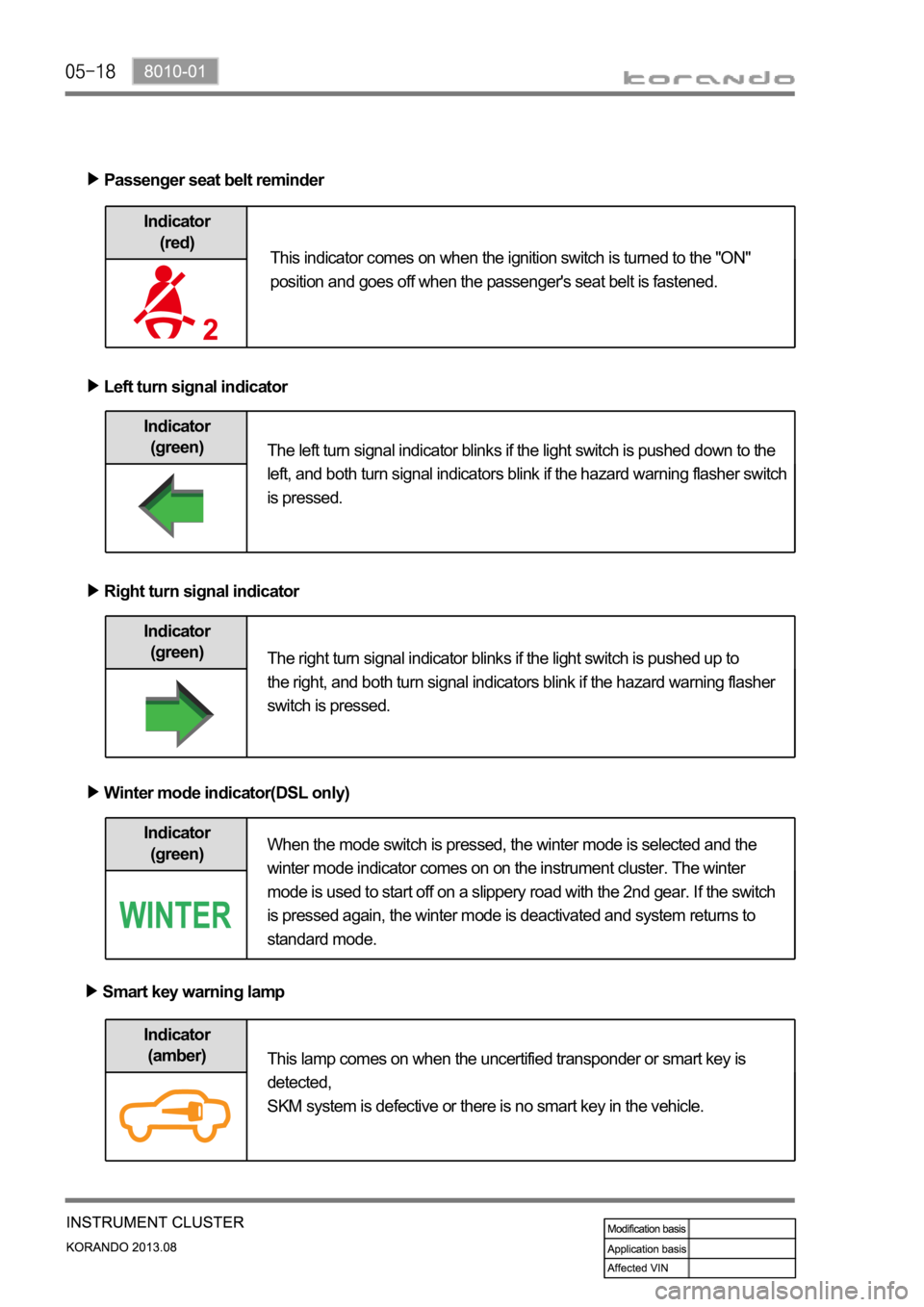
Indicator
(green)
Passenger seat belt reminder
Left turn signal indicator
Right turn signal indicator
Indicator
(red)
Indicator
(green)
Indicator
(green)
Winter mode indicator(DSL only)
The right turn signal indicator blinks if the light switch is pushed up to
the right, and both turn signal indicators blink if the hazard warning flasher
switch is pressed.
When the mode switch is pressed, the winter mode is selected and the
winter mode indicator comes on on the instrument cluster. The winter
mode is used to start off on a slippery road with the 2nd gear. If the switch
is pressed again, the winter mode is deactivated and system returns to
standard mode.This indicator comes on when the ignition switch is turned to the "ON"
position and goes off when the passenger's seat belt is fastened.
The left turn signal indicator blinks if the light switch is pushed down to the
left, and both turn signal indicators blink if the hazard warning flasher switch
is pressed.
Smart key warning lamp
Indicator
(amber)
This lamp comes on when the uncertified transponder or smart key is
detected,
SKM system is defective or there is no smart key in the vehicle.